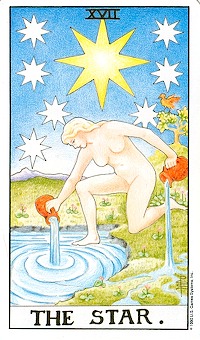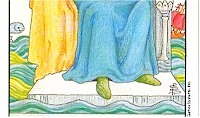By Peggy Firth, CTM
These days, students of the Tarot often expect to begin reading the pip cards immediately. My solution has been to reflect each image back to the student. Following my introductory course, students may adjust and expand their meanings as they delve more deeply into the Tarot. In the beginning, I do not expect memorization, and I do not expect students to tackle reversals, astrological or numerological meanings, or the study of dignities. The emotional and experiential reactions to the images seem to work best. The following groupings of images are discussed.
In Victorian times, flowers served as symbols to communicate feelings. (The Society of American Florists has compiled a list of over a hundred such meanings.) Roses signified passionate love, and the color of the rose signified a more specific kind of love. The pip cards are full of flora symbolizing the seasons, youth, beauty, passion, joy, abundance and growth. Personal experiences with flowers, and the color and abundance of flowers in a pip card, allow the student to create their own meaning.
Most pip cards of the Rider Waite deck portray weather patterns which affect a mood and meaning behind the images in the foreground. These cards are filled with skies of deep color, billowing clouds, storms, and windy scenes. Nighttime skies or the images that play against a black background speak of the mysterious or unseen. The Ten of Swords may seem a rather gruesome image until the reader takes in the dawn or sunset colors. Other dark backgrounds such as the Five of Pentacles might represent desperation and the inability to see the good within, depicted by the stain glass window. Stars denote a connection with spirit, guidance, and inspiration. Star shaped flowers are also depicted in the Six of Cups and other Major Arcana cards. The moon is also depicted in several cards as full or waning. The moon’s gravitational pull governs our moods and is a constant rhythm in our lives. Stories abound in historical literature that connect the phases of the moon with our lives. These universal meanings are discussed, but ultimately, the challenge has been to weave these meanings into the student’s experiences and preferences.
In the Middle Ages, a time of great fear, ignorance, and dominance of the church and royalty, images of animals and other small creatures were often used as symbols of the nature of life, and animal imagery in the pip cards can help the student decipher meaning. As another example, the reader may choose to incorporate into their readings the belief systems of indigenous peoples, which tend to be more in harmony with nature. Tarot students are encouraged to create their own glossary of creatures and their meanings.
In the Rider Waite deck, half of the cards have images of water in the form of ponds, oceans, waterfalls, streams, or cups of running water. Water symbolizes the soul, the inner life, mystery, and the unconscious. Water is also linked to the feminine nature. Water also reflects the weather, and may be turbulent, roiling, or smooth. The King of Cups, a mature and responsible personage, sits upon a throne made of stone set upon foaming waters.
Every belief system seems to have an explanation for how destructive forces occur, their timing, and their extent of ruination. We discuss how the reader regards these forces and how they interact with the action of the players on each card.
The sheer number of ways to interpret each card depending upon the querent, the placement within a spread, and our own perceptions, makes Tarot reading such an adventure. I hope that I may be able to further share the adventure of Tarot imagery.
My website, www.amazing-psychic-revelations.com, addresses most of the natural imagery of the Rider-Waite deck.
All images in this article are from the cards of the Universal Waite, published by U.S. Games Systems, Inc. The Universal Waite Tarot copyrighted by U.S. Games Systems, Inc and is used with permission.





